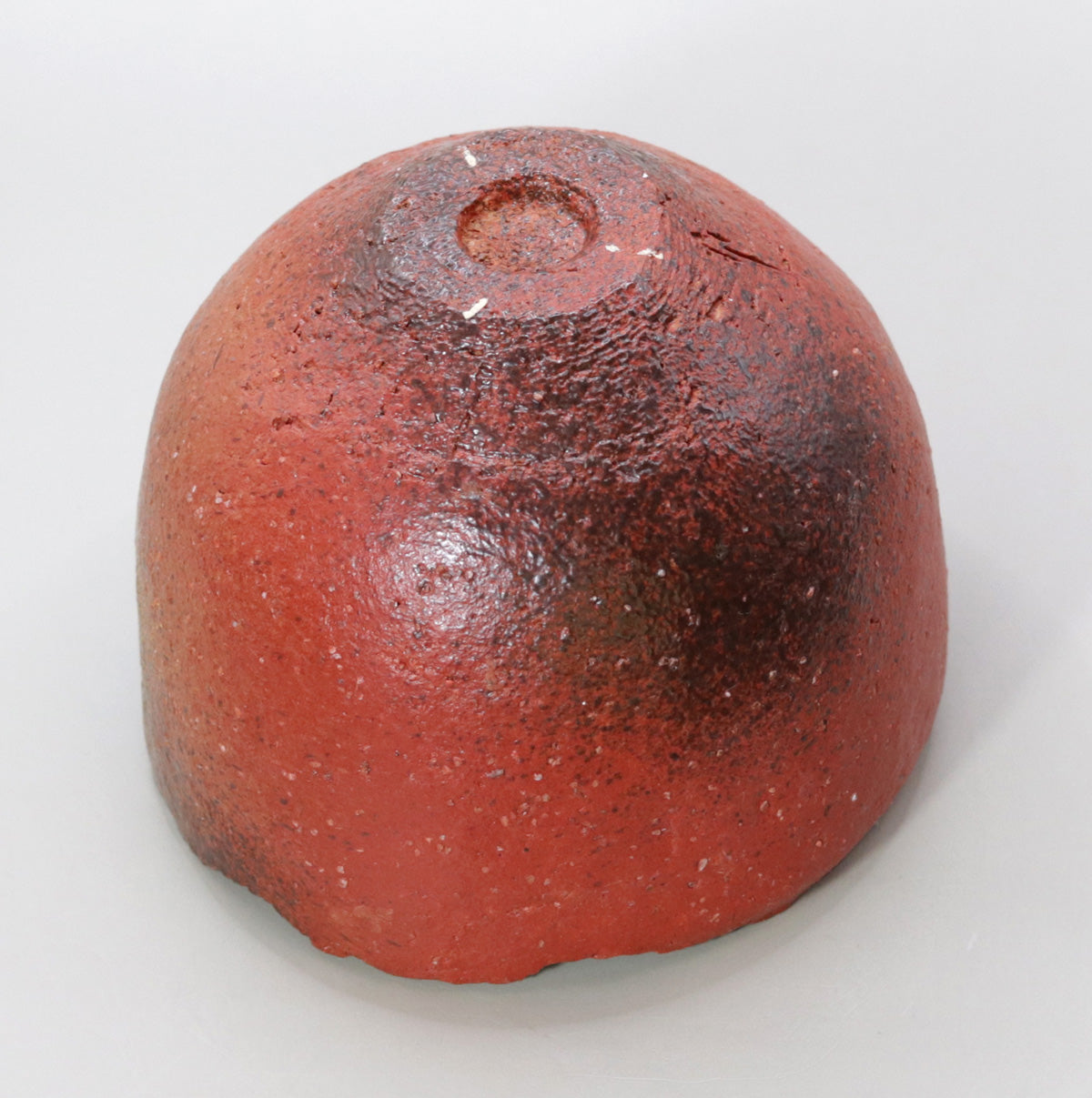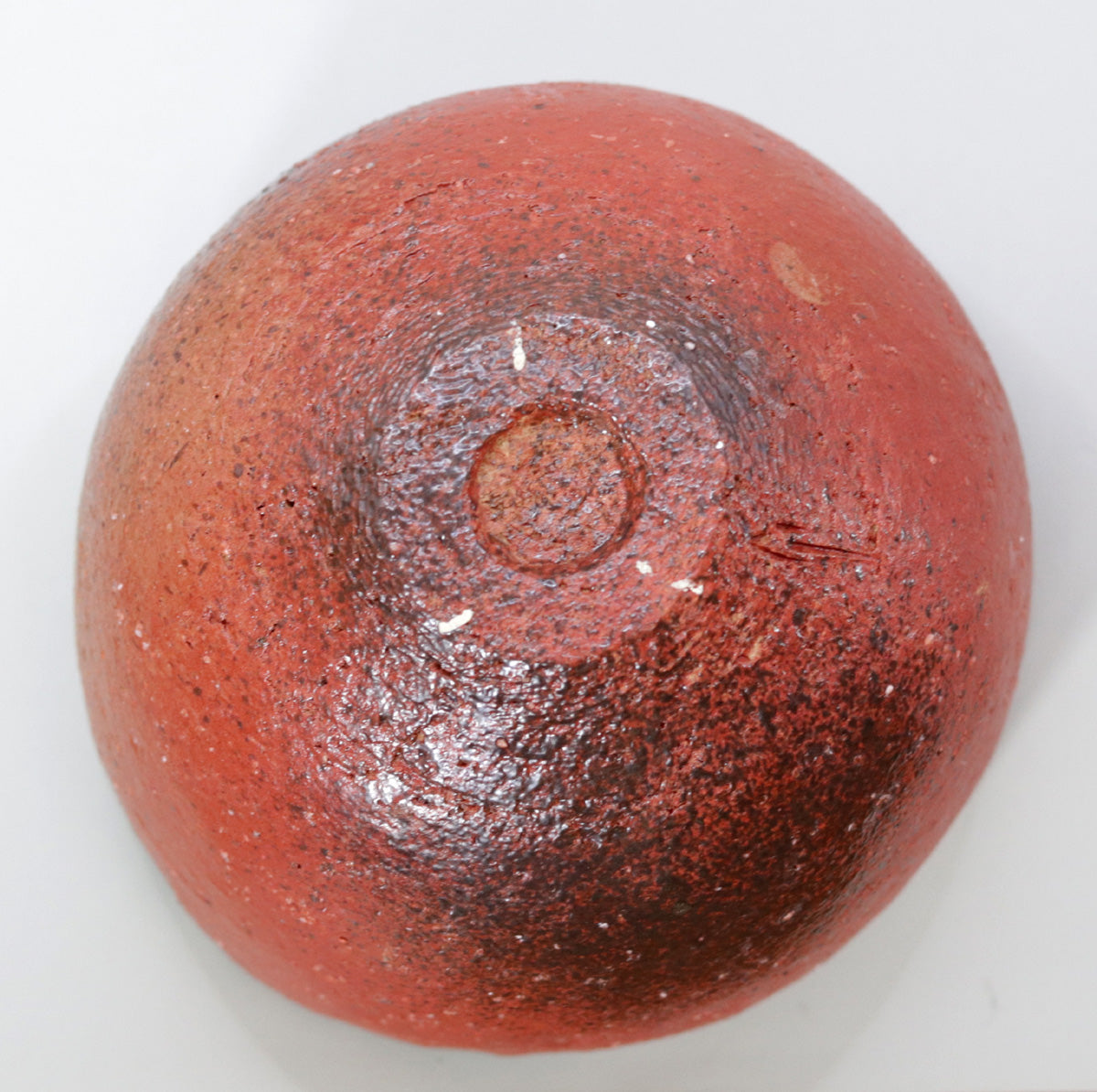Tanba Red Tea Bowl Nishitan Masashi
Tanba Red Tea Bowl Nishitan Masashi
Couldn't load pickup availability
Width: 14.0cm Depth: 13.2cm Height: 10.6cm
1. Carbonized Landscape Hiding in a Scarlet Veil
The red that covers the exterior walls is a color achieved by first firing iron-rich Tanba clay to a dark brown through strong reduction, and then shifting to an oxidizing atmosphere in the final stages. From the base to the slope, the remaining ink-black color from the reduction process appears like a gradation, creating a scene that looks like patches of soot rising from the embers. This gradation of red and black condenses the temperature difference and drama of oxidation and reduction created by the flames, and it seems to send a quiet warmth into your heart every time you look at it.
2. The wavy rim - a design reminiscent of the unevenness of lava
The rim is gently wavy all the way around, with large indentations and thinly shaved areas mixed in here and there. This natural undulation is the result of pushing the clay back with the fingers after shaping it on the potter's wheel, and combined with the rough outer surface, it evokes the ridges of a lava dome carved by wind and fire. The feel in the mouth changes depending on where the lip rests, adding a subtle playfulness to the tea ceremony.
3. The wonderful texture created by the coarse soil
The rough clay from Tanba contains many feldspar grains and tiny particles of iron ore, and these particles remain clearly visible even after firing. The tiny iron flecks and white quartz grains sparkle like stardust on the scarlet surface, and the shadows shift depending on how the light hits them, creating a deep, three-dimensional effect despite the single color. When you pick it up, it has a rough texture, giving you the tangible feeling of touching clay with your fingertips.
4. The light of the carbonized glaze rising from within
A semi-glossy crimson color spreads from the inside to the inner wall, creating a contrast with the matte red of the outer wall. The iron that turns into a glaze during firing takes on a glassy quality, and thin areas that have accumulated give off a dull metallic glow. When matcha is poured into the vessel, the three colors of green, red, and black intertwine, creating a fantastical scene that makes it seem as if a single drop of the universe is held in the palm of your hand.
5. Lightweight, thin construction and functional beauty
The body is slightly thinly milled and precisely fired at high temperatures, resulting in a surprisingly light weight. The inside is hemispherical, so it does not interfere with the movement of the tea whisk, making it versatile enough to be used for both thin and thick tea. The foot is cut low, and the reddish-brown base remaining around the base lowers the center of gravity of the entire vessel while ensuring stability on the table.
6. The coexistence of wabi-sabi and the brilliance of flames
In wabi-cha tea, tranquility and simplicity are valued, but this piece, while clad in a strong scarlet color, suppresses excessive gaudiness with the roughness of the earth and the black of the ash, allowing wabi-sabi and vitality to coexist in an exquisite balance. Nishibata Tadashi says, "The red of Tamba is a color that dwells on the boundary between fire and earth," and by making the most of the scarlet color depicted by nature and avoiding artificial decoration as much as possible, he has sealed the energy of earth and fire itself into the vessel.
7. Variations of red woven by the years
The matte scarlet exterior absorbs the oils from hands over many years of use, gradually acquiring a moist luster. The remaining ink-black color from reduction turns softer and browner, while the semi-gloss interior mixes with tea stains and takes on a dull metallic sheen. Because it has no crazing, the passage of time is slower, but its greatest appeal lies in the fact that it will quietly mature in harmony with the owner's lifestyle, developing into a one-of-a-kind landscape.
The breath of the embers turns this Tanba Red Tea Bowl crimson, revealing the rough surface of the Tanba earth. When held in the palm of your hand, it conveys a quiet yet certain heat and rustic charm, adding a touch of flame to the once-in-a-lifetime experience of the tea ceremony. We hope you will treasure it for a long time and enjoy the color that deepens over time as the red breathes.
Tadashi Nishibata Biography
Born on February 24, 1948. Started making pottery in 1969. 1976. Hyogo Prefectural Exhibition Encouragement Award. 1986. Selected for the Japan Traditional Crafts Exhibition for the first time. 1988. Selected for the Japan Traditional Crafts Exhibition. Japan Traditional Crafts Exhibition. Japan Crafts Association President's Award. 1989. Selected for the Japan Ceramic Art Exhibition. Nogawa Memorial Award, Handon no Kai. 1991. Selected for the Japan Traditional Crafts Exhibition. Selected for the Japan Ceramic Art Exhibition. Grand Prize at the Tea Ceremony Forms Exhibition. 1992. Selected for the Japan Traditional Crafts Exhibition. Excellence Award at the Tea Ceremony Forms Exhibition. Hyogo Prefecture Emerging Artist Encouragement Award. Invited to exhibit at the NHK-sponsored Paris - 100 Contemporary Japanese Ceramics Exhibition. Excellence Award at the Tea Ceremony Forms Exhibition. 1993. Selected for the Japan Traditional Crafts Exhibition. Solo exhibition at Sogo Hiroshima store. Kyoto Chemin. 1994. Selected for the Japan Traditional Crafts Exhibition. Solo exhibition at Nihonbashi Mitsukoshi Main Store. 1995. Selected for the Japan Traditional Crafts Exhibition. Solo exhibition at Sogo Hiroshima store. 1996. Selected for the Japan Traditional Crafts Exhibition. Awarded the Excellence Award at the Tea Ceremony Design Exhibition, solo exhibition at Nihonbashi Mitsukoshi Main Store
1997 Encouragement Award at the Tea Ceremony Design Exhibition 1998 Selected for the Japan Traditional Crafts Exhibition Solo exhibition at Mitsukoshi Nihonbashi Main Store Selected for the Japan Traditional Crafts Exhibition 2000 Solo exhibition at Mitsukoshi Nihonbashi Main Store Solo exhibition at Mitsukoshi Fukuoka 2001 Selected for the Japan Traditional Crafts Exhibition 2002 Solo exhibition at Mitsukoshi Nihonbashi Main Store Solo exhibition at Gallery Dojima 2003 Solo exhibition at Touchingston, USA 2004 Grand Prize at the Tea Ceremony Design Exhibition at Sogo Hiroshima 2005 Exhibited at the Akashi City Museum of Culture and Hyogo Ceramics Exhibition Purchase of Akadobedai, Hyogo Ceramic Art Museum Solo exhibition at Gallery Dojima, Mitsukoshi Nihonbashi Main Store 2006 Grand Prize at the Tea Ceremony Design Exhibition Selected for the Japan Traditional Crafts Exhibition at the Museum of Fine Arts, Boston and the New York Japan Society Gallery Solo exhibition at Yokohama Takashimaya Touchingston, USA Father and Son Exhibition at Matsuyama Takashimaya Toshunkai Exhibition, Sogo Yokohama. Encouragement Award at the Tea Ceremony Art Exhibition. Selected for the Japan Traditional Crafts Exhibition in 2008. Selected for the Japan Traditional Crafts Exhibition. Solo Exhibition, Yokohama Takashimaya, Mitsukoshi Nihombashi, Santa Fe, Touchingston, USA. Toshunkai Exhibition, Funabashi, Seibu, Sogo Hiroshima. Invited to the Japanese Ceramics Exhibition in 2009. Solo Exhibition, Gallery Dojima, Sendai Mitsukoshi, 2010. Sogo Kobe. Exhibited in the Musee Tomo Grand Prize Exhibition, Contemporary Tea. Solo Exhibition, Yokohama Takashimaya, Touchingston, USA. Invited to the Japanese Ceramics Exhibition. Solo Exhibition, Joan B. Marvis, New York, USA. Invited to the Japanese Ceramics Exhibition in 2013. Exhibited in the "Contemporary Famous Bowls" exhibition at the Musee Tomo, Kanmi Kikuchi Memorial. Solo Exhibition, Mitsukoshi Nihombashi, Santa Fe, Touchingston, USA. Gallery Miyazaki, Sogo Kobe, Chiba Sogo, 2014. Solo Exhibition, Mitsukoshi Nihombashi, 2015. Received the Hyogo Prefecture Cultural Award in 2016. Exhibited at Higashihiroshima City Museum of Art for "Ceramics that Color Our Lives - Food Ware" Exhibited at Joan B. Marvis' 40th Anniversary Exhibition in 2017.
2018 Solo Exhibition at Nihonbashi Mitsukoshi Main Store
Share








Multi-Column
-
[I will send it to you quickly and carefully]
We carefully package each product in a way that suits it best.
Also, delivery times vary depending on the piece (vessel, etc.).
Items that already come with a box will be shipped within 1-3 days of the order date.
For items that require a box to be made after your order, it will take approximately 30 days for production to be completed and then shipped.
In either case, once we have confirmed your order, we will contact you by email to inform you of the delivery date.
-
[Requests when purchasing pottery]
Even products that look the same may differ slightly in color, shape, size, etc.
The way the glaze is used, the power of the kiln, the firing method, the season, and the humidity also affect the appearance of the pottery.
Please understand the individuality of each piece of pottery and enjoy the unique warmth of handmade.
